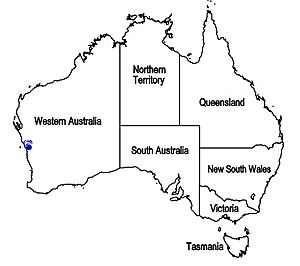Dicrastylis incana facts for kids
Quick facts for kids Dicrastylis incana |
|
|---|---|
| Conservation status | |
| Scientific classification | |
 |
|
| Synonyms | |
|
Dicrastylis morrisonii Munir |
Dicrastylis incana is a special kind of plant. It belongs to a group of plants called Dicrastylis. This plant is part of the Lamiaceae family, which also includes mint! You can only find Dicrastylis incana in Western Australia. This means it's a unique plant to that area.
Contents
What Does This Plant Look Like?
Dicrastylis incana grows as a shrub. It spreads out and can be anywhere from 30 centimeters (about a foot) to 1.5 meters (about five feet) tall. You'll often find it growing in open woodlands on yellow sandy soil.
Stems and Leaves
Its stems are mostly round when you look at them from the side. The leaves grow in pairs, one across from the other. They are 10 to 24 millimeters long and 1.5 to 7 millimeters wide. These leaves have special branched hairs, which look a bit like tiny trees.
Flowers and Petals
The plant has small stalks that hold its flowers. These stalks are 2 to 4 millimeters long and also have branched hairs. They also have tiny, shield-shaped hairs. The green part that protects the flower bud, called the calyx, has five small parts. These parts are 1.5 to 2 millimeters long and are covered in branched hairs.
The petals of the flower, called the corolla, are white to cream colored. They are 5 to 8 millimeters long. You won't see any dots or stripes inside the flower's opening. Each flower has five stamens, which are the parts that make pollen. You can usually see these flowers from September to November.
Where It Grows
This plant is found in a specific area of Western Australia. This region is known as Beard's South West Province.
How Was This Plant Named?
Dicrastylis incana was first officially described in 1978. It was named by a scientist named Ahmad Abid Munir. When a plant is "described," it means a scientist has studied it carefully and given it a unique scientific name.


